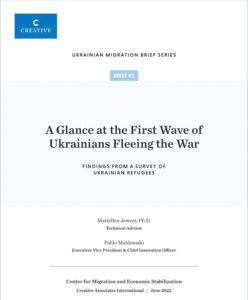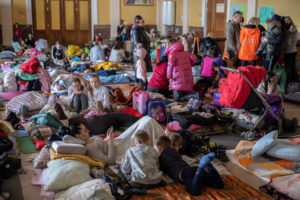Ukraine’s refugees are out of displaced shelters, but are determined to return home, Creative study finds
The Center for Migration and Economic Stability’s survey examines Ukrainian refugees’ medium-term plans and financial resilience
By Sabra Ayres
As Russia’s invading forces began intense bombardments on Ukrainian cities 100 days ago, nearly 7 million Ukrainians fled their country seeking safety across the border into Poland and other European nations.
A new study by Creative Associates International’s Center for Migration and Economic Stability provides an insightful portrait of those initial refugees, including the conditions under which they have forcibly migrated, their destinations well beyond border countries and their sentiments and preoccupations as they negotiate their new places of residence.
“The study aimed to look beyond immediate humanitarian needs, which humanitarian organizations are collecting data on, to understand refugees’ financial resilience, plans for livelihoods and medium-term plans for residence,” says Mariellen Jewers, Ph.D., the Technical Advisor at the Center for Migration and Economic Stability.

Of those who were forced to flee across the border, the survey found most were women aged 30 to 39, and many traveled with one or more school-aged dependents. A large majority of those surveyed—71 percent—had a university degree or higher and planned to find work where they settled to help support their dependents. However, many respondents said they were worried whether their education credentials would transfer to a foreign country, the report said.
The survey’s results are the first of three studies in Creative’s Ukrainian Migration Brief Series, which looks to frame challenges and opportunities confronting Ukrainian refugees, as well as to gauge the sentiments and appetite of Ukrainian residents towards potential migration in the future.
The results are based on a digital survey conducted by Creative in April 2022 with 520 respondents. Creative contracted with a premier polling agency in Poland, which had offices and operations in Ukraine before the war.
Most of those surveyed reported access to online financial products, such as savings accounts and credit cards. Only 8 percent of respondents were unemployed before the war, which is slightly lower than 2020 unemployment rates for women in Ukraine.
“We’ve learned that Ukrainians were, before the war, highly connected globally, a factor that enables migration,” says Pablo Maldonado, Creative’s Executive Vice President and Chief Innovation Officer. Maldonado heads Creative’s Office of Innovation, of which the Center for Migration and Economic Stability is part.
“We found it remarkable that the population we interviewed was highly employed prior to migrating and that a not insignificant number of migrants were able to continue to work remotely,” he adds.
A small share of respondents reported living in a refugee center. An examination of the result shows also that Ukrainian refugees spread out once they crossed the border. While Poland has borne the brunt of the refugee crisis in the beginning stages, the survey found that Ukrainians have found temporary settlements across Europe, as well as in the United States and other countries. Because of Ukrainians’ strong diaspora network, many refugees had international connections on whom they could turn by the time they left their country, the study found.
“As we know, before the war, Ukraine had a substantial diaspora population worldwide and was among the top 10 migrant-sending countries in the world,” Jewers says. “Respondents in our study had relatives abroad and a fifth were receiving remittances at the time of the survey.”
A great number of respondents all shared an important sentiment: They planned to return to their country for the long term, the study found. Most respondents expected to move to another country in the short term, with 31 percent saying that they didn’t know how long they could remain in their current location. Two-thirds of respondents said they expected to stay in their current location for less than a year.
An estimated 2 million of the nearly 7 million Ukrainians who fled in the first months of the war have already crossed back into Ukraine, according to the United Nations High Commissioner for Refugees.

With no end in sight in Russia’s war in Ukraine, the needs of Ukraine’s displaced will continue to put pressure on host governments and humanitarian organizations to respond. .Creative’s Center for Migration and Economic Stability plans to conduct at least two more briefs on Ukraine.
“The results from Creative’s survey and our follow-on studies of forcibly displaced Ukrainians will be used to anchor our understanding of people’s sentiments and plans for rebuilding their lives in the medium and long-term and shape how we can work alongside local partners to support these individuals,” Jewers says.
Creative seeks to provide beyond-the-horizon analysis, certainly past the humanitarian phase, to ensure Ukrainian migrants succeed in their new homes and can be understood and eventually attracted to return home, Maldonado adds.
“Importantly, if not strategically, we want to frame the risk of new waves of migration and to provide data-informed insight on how to prevent massive migration,” he says.
Young, educated Ukrainians will be needed for the successful reconstruction of the country, Maldonado says, adding that retention strategies must be sophisticated and appealing.
To learn more about Creative’s work in disasters and crisis areas, please click here.

